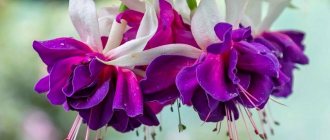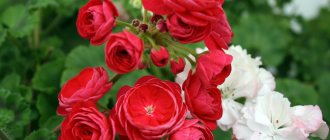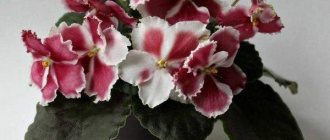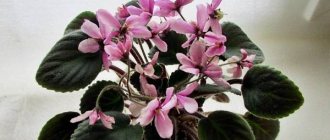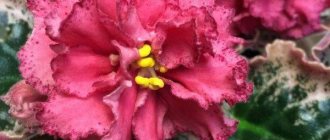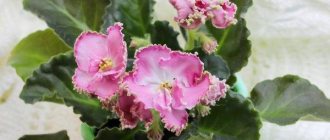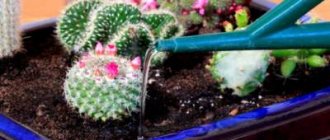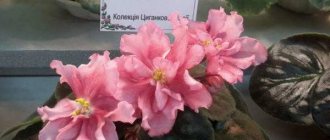Konstantin Morev practices an unusual way of getting rid of seedlings that he rejected for various reasons. Many breeders consider the sale of such seedlings to be incorrect, because these are untested Saintpaulias.
Some of these babies receive a name from the owners,
often this name goes to the people and takes root , as a distinctive sign in the name there is a prefix SM - Morev seedling.
More often than not, stand-out examples receive recognition, and their owners check them for repeatability. Morev himself is against this practice, and even the seedlings tested by collectors are not recognized as varieties. There are different opinions about the reasons for selling seedlings , if he is against calling them varieties and recognizing:
- Some believe that this is a way to earn additional income;
- Others think that he is simply sorry to destroy them.
Flower growers consider these seedlings on a par with varieties, the only difference being the lack of an author's description of the variety and precise information about repeatability. But these factors can be seen on forums, where the owners of these beautiful Saintpaulias describe them and present their photos, and also discuss their experience of growing them.
In the article you will learn how to grow varieties of violets by K. Morev (SM):
- Nectarine;
- Smoke on the water;
- Old Arbat;
- Motley Rhapsody;
- Viva la Vita;
- Coral reefs;
- Dancing Elves;
- Sweetheart;
- Empress.
Important! There are several exceptions among the Morev seedlings; buyers checked them and the breeder still recognized these Saintpaulias as varieties.
Violet SM-Nectarine
Beautiful violet Nectarine.
One of the seedlings of Konstantin Morev. It is distinguished by especially large flowers, up to 7 cm, the shape is quite unusual, semi-double or double. Usually has a pink-coral tint , which greatly depends on the conditions of detention, and more often it blooms simply pink.
The rosette is medium in size , and the leaves are quite large on medium-length cuttings. The shade of the sheets varies depending on conditions, but is usually dark green and uniform.
There cannot be official sports, since the seedling is not recognized as a variety . But among flower growers, SM-Nectarine has long been tested and is used relatively rarely, out of 10 seedlings there are only 1-2.
Violet SM-Viva La Vita is similar in color to this variety.
Attention! Most often it produces simple flowers instead of double flowers or a different color of petals.
Features of care
The variety is not whimsical and does not require special care . It is enough to provide good lighting to obtain:
- Correct and rich color of flowers;
- And also a symmetrical, neat outlet.
Good feeding and timely watering gives a strong and well-formed bush (reacts well to wick watering).
Reproduction is carried out by all vegetative methods:
- Leaf cuttings take root well and produce several children at a time;
- Peduncles take root less well, but convey the unusual color of flowers well;
- It is rarely done, but this method brings the least number of sports.
Reviews
Inna. “My Nectarine makes me very happy. Blooms profusely and regularly. I bought it as a varietal baby, only later I found out that it was a seedling, but I don’t regret it. When propagated, the repetition is very good as for a seedling. Out of 10, only 2-3 of me do not replicate their mother’s characteristics.”
Tatiana. “I removed all Moreva seedlings from my collection. I bought them around the same time, and when they started to bloom I was disappointed. Maybe my conditions didn’t suit them, but none of them impressed me and didn’t even come close to expectations. To be sure, I let them bloom in the second round and gradually distributed everything.
SM-Nectarine is one of the disappointing ones. My flowers were small and the color was very ugly.”
Violet SM-Smoke Above Water
Mysterious violet Smoke On The Water.
An excellent representative of the genus of hybrid Saintpaulias , another unrecognized Morev seedling variety.
The flowers are very unusual, semi-double with unusually thin petals that are corrugated only at the tips. The color is also quite unusual:
- The blue petals at the base fade smoothly into blue;
- And the edges and fringe are gray-green.
The rosette is slightly spreading through elongated and thin leaf stalks. The leaves are round with pronounced teeth along the edge. The color of the leaves is dark green with a pronounced network of veins.
During propagation, characteristics are often transferred, but among the reviews and data on the seedling, there is no exact information about what sports are.
Features of care
The variety does not require any special conditions. Even in good lighting:
- The sheets stretch;
- The rosette is not formed symmetrically;
- Peduncles are also prone to elongation.
Watering should not be too abundant, and it is also not recommended to use the wick type of watering; it promotes even greater elongation of cuttings and flower stalks.
It is recommended to feed SM-Smoke over water well, because a lack of minerals and nutrients leads to a deterioration in the appearance of the outlet.
Reviews
Oleg. “The flower is simply incomparable, but the rosette was a little disappointing. Sprawling and sloppy. The only plus of the variety is the unusual colors. For now he lives with me, but I’ll try to change the conditions.”
Allah. “I bought it as an adult, flowering bush. I really liked the flowers. Under my lamps, the rosette looks pretty decent and doesn’t pull the leaves too much, but the peduncles are a bit long.”
Disease prevention and pest control
Improper care of violets leads to its infection with fungal diseases:
- Late blight. The causative agent of the disease is a fungus transmitted through the soil and activated at high air humidity and high or low air temperature. Violet leaves become covered with brown spots. The disease is treated with Fitosporin. A plant severely affected by the disease cannot be saved. Therefore, it is best to root the remaining healthy leaf.
- Fusarium. A fungal disease that develops when watering with cold water and waterlogging of the soil. A sign of the disease is wilting leaves.
- If the violet is affected by powdery mildew, the plant is treated with Topaz or Fundazol.
Powdery mildew of violets . The leaves are covered with a whitish coating. The fungus enters the plant through the soil or by air with dirty water. The development of infection starts with cold, lack of light, waterlogging of the soil, and excess nitrogen in fertilizing. The disease is treated with Fundazol and Topaz.
- Gray rot. Violet leaves become covered with brown spots, on which a smoky gray coating gradually appears. The disease can be cured only in the early stages by removing the affected leaves and spraying the violet with a solution of copper sulfate or potassium permanganate.
- Vascular bacteriosis. It affects the violet in the heat, when the plant begins to have metabolic disorders in its tissues. The leaves and petioles of the plant become glassy, then turn into “jelly”. The rosette dies within 2-3 weeks. At the first signs of the development of the disease, it is necessary to reduce the temperature of the violet and treat it with a solution of trichodermin.
Dangerous enemies of violets that can cause irreparable harm to the plant are insect pests:
- aphid;
- thrips;
- scale insect and false scale insect;
- mealybugs;
- nematodes;
- mites.
Pest control must begin at the first sign of their appearance. The infected violet needs to be transplanted into a new pot, replacing the soil and removing all leaves affected by pests. Then the plant needs to be sprayed with an insecticide: Fitoverm, Aktara, Alatar, etc.
Important. If small swellings are found on the roots of a violet, then the plant is infected with a root-knot nematode. It is impossible to destroy the pest, so the violet will have to be destroyed. To preserve the variety, you can root a leaf cutting after pre-treating it with a solution of potassium permanganate.
Violet SM-Old Arbat
Saintpaulia Moreva Old Arbat.
A very beautiful seedling by Konstantin Morev. Socket :
- Flat;
- Symmetrical;
- Almost exhibition.
The leaves are on short, rather thin cuttings, evenly distributed around the bush. The shape is heart-shaped , with small teeth along the edge, light green in color.
Flowers on strong peduncles:
- Several pieces each;
- Very big;
- Up to 6-7 cm;
- Forms a beautiful hat.
The shape of the flowers is simple and semi-double, the petals may not even be separated from each other , there is a pronounced corrugation along the edge. The color is violet-pink, with a slight darkening along the edge and a pencil violet-blue border.
Features of care
SM-Old Arbat care requires the use of classical methods of caring for Saintpaulias:
- The lighting is bright without direct sunlight;
- Moderate watering in the pan or under the leaves (reacts well to wick);
- Regular feeding - through watering;
- Replant as needed;
- Regular removal of aging parts of the plant.
It reproduces well, and the repeatability has been tested by gardeners, and the result is very good .
Reviews
Alice. “The rosette is beautiful, almost for show. It grows well on my windowsill, forming beautifully. The flowers are simply incomparable, the size, color and border simply fascinate me.”
Paul. “My variety has taken root well. During reproduction, it retains external data well. The rosette itself is beautiful and blooms beautifully. I adore this beauty and recommend it to everyone, despite the fact that it is only a seedling.”
About the breeder
Tatyana Lvovna Dadoyan is a Russian breeder . Tatyana herself cannot stand it when the word “breeder” is applied to her. The activities of this woman remained secret for a long time.
She was engaged in breeding new varieties of violets exclusively for herself; this activity was a hobby for her. Dadoyan released her plants to people in 2012, when she heard that all combination options in the selection of Uzambara violets had already been sorted out and there could be no new discoveries.
Reference! She presented about 10 varieties of her violets to the society. These plants seem perfect. They have incredible colors and shades, and they have a chic shape. And the rich and long flowering can captivate any gardener and lovers.
Do you want to know more about other types and varieties of Saintpaulias with the names of the people who grew them? Read our articles about breeders:
- Tatyana Pugacheva;
- Natalia Skornyakova;
- Korshunova Elena;
- Natalia Puminova;
- Evgeniy Arkhipov;
- Konstantin Morev;
- Svetlana Repkina;
- Elena Lebetskaya.
Violet SM-Motley Rhapsody
Charming Saintpaulia Motley Rhapsody.
Quite an unusual Saintpaulia , one of the many beautiful seedlings of Morev. Socket:
- Beautiful;
- Flat;
- Symmetrical;
- Well formed.
The leaves are on strong cuttings, round in shape , with light teeth. The color is rich green, often dark green with white variegation along the edge, which can be:
- Almost invisible under certain conditions of detention;
- Or vice versa, quite wide and bright.
The flowers are simple, medium-sized, pansy-shaped . The main shade of the flower is white, there is a spot on each petal, it is darker on the lower (larger) petals, and pale, sometimes almost invisible, on the upper two petals. The wavy edge of the flower gives the seedling a special charm and adds tenderness.
Features of care
All features in caring for SM-Motley Rhapsody are related to the color of the leaves and flowers:
- For beautiful leaf variegation, it is important to give the plant enough nutrients, as well as observe the light and temperature conditions. The lighting should be a little more subdued than for other varieties of Saintpaulia, and the temperature should be 2-3 ° lower;
- White flowers with imprints on the petals tend to float or, on the contrary, fade, this is due to temperature conditions. The higher the tempera, the larger the size and richer the color of the spots, and the lower, the paler and smaller the prints.
In breeding SM-Motley Rhapsody, it is recommended to give preference to :
- Leaf cuttings;
- Stepsons.
When using flower stalks for propagation, there is a possibility of losing the variegation on the leaves.
Reviews
Irina. “I love pansies, and this variety makes my dreams come true. I love the color, and the variegated leaves are a dream for me. I am growing and developing well. It repeats beautifully, and the children’s variegation is beautiful.”
Daria. “The variety didn’t take root with me; for me these pansies are very pale. The leaves are beautiful, but the flowers were not impressive. I gave my beauty to a friend, but she is growing and developing well.”
Conditions of detention and care
Like all variegated varieties, Svetlana violet needs intense lighting. The plant will feel best under fluorescent lamps on a shelf. The height of the lamp is 25-30 centimeters. The violet's daylight hours should be at least 12 hours.
For growing in natural light, north-eastern or north-western windows in summer, eastern or western windows in winter are ideal.
Important. Keeping it on south-facing windows, even with shading, is not recommended. Variegated varieties are extremely sensitive to sunlight. Excess light will lead to an almost complete disappearance of the green pigment on the leaves.
To maintain variegation, the temperature of the violet should not exceed 21-22 degrees. At higher temperatures, the plant will increase chlorophyll production and the leaves will turn completely green. Elevated temperatures also negatively affect leaf size. They become small and may even become deformed.
Rules for watering violets Svetlana
An important factor in caring for variegated violets is the use of soft, slightly acidified water. Hard water alkalizes the soil and reduces the absorption of nutrients. Before watering, water must be left to stand for at least 2 days. Additionally, add a small amount of apple cider vinegar or citric acid to the water.
There are several ways to water the Svetlana violet.
Watering is organized in three ways:
- Upper. Water is poured into the edge of the pot in small portions.
- Lower. The pot of violet is placed in a pan of water for 20-30 minutes.
- Wick. The violet independently absorbs the amount of water it needs through a wick placed in the pot - a cord made of synthetic material with a diameter of 0.3-05. centimeters. The end of the cord is passed through the drainage hole and placed in a container of water.
Important. The soil in the violet pot should be slightly moistened. The plant does not tolerate waterlogging or drying out of the earthen clod.
Features of the organization of fertilizing
Feeding Svetlana violets has some features. It is necessary to carefully monitor the amount of nitrogen in fertilizers. This substance promotes the production of chlorophyll and leads to the dominance of green color in the leaf blade. When there is an excess of nitrogen, the beautiful leaf pattern disappears, and the plant may lose its decorative appearance.
[adsp-pro-5]
The Svetlana violet is fed with organic fertilizer twice with an interval of 30 days during the formation of the rosette. During the set of buds and flowering, fertilizing is carried out 2 times a month with mineral fertilizers, the main elements of which are phosphorus and potassium.
Violet SM-Coral Reefs
Delicate violet Coral Reefs.
Seedling Moreva SM-Coral Reefs is a beautiful Saintpaulia that shows itself well in the collections of gardeners.
The rosette is very smooth and forms perfectly on its own . Sheets:
- Rounded;
- Slightly jagged;
- Light green color.
The formation of a bush is easy , thanks to strong, short cuttings on the leaves.
Flowers rise above the rosette on strong peduncles; cap flowering is rare for this variety. Flowers:
- Huge;
- Terry stars;
- With pronounced waviness along the edge of the petals.
The color is very delicate, the main white color is perfectly complemented by pink-coral prints.
Features of care
To obtain the ideal color of flowers and an even rosette, it is necessary to observe the appropriate light and temperature conditions :
- The lighting should be saturated, but without direct sun (it may darken under lamps);
- The temperature must be maintained at the optimal level - the lower you go, the less coral part on the petals, the higher it is, the brighter and more prints.
Attention! In particularly hot times, the flowers can be a completely rich coral color.
Reviews
Valentina. “I bought a rooted leaf, the baby appeared quickly and developed well. During the first flowering it was almost white, but from the second it acquired the correct color. I liked the socket, but in my conditions it’s a bit spread out, it pulls sheets and that’s it.”
Michael. “A very pale and unremarkable Saintpaulia. I like it in every way except the color. Mine turned out not quite the same as other gardeners’, like sports, the petals are almost white, but I’m happy with everything.”
Reproduction methods
The main methods of propagation of the Svetlana variety are rooting of violet leaf cuttings and shoots of stepsons.
Violet Svetlana can be propagated either by rooting a leaf or by separating a daughter rosette.
Rooting a leaf cutting
Propagation by leaf cuttings is recommended in spring. A healthy, undamaged leaf that is not too old and not too young is cut from the plant. The choice is made on a leaf in which green color predominates and the variegation is less pronounced.
An oblique cut is made on the cutting and placed in a glass of water. Immersion depth is no more than 1 centimeter. After roots 1-1.5 centimeters long grow on the cuttings, it is planted in a glass filled with a mixture of vermiculite, sand and peat.
[adsp-pro-6]
The planted leaf is covered with a transparent cap, under which moisture and heat are better retained. The cuttings cannot be placed too deep into the soil; it will be difficult for the children to break through to the light.
Babies on the cuttings appear after 6-8 weeks. During the rooting process, completely white or cream babies grow on the cuttings. Without the mother's leaf, such children will not be able to survive . First you need to ensure that at least two green leaves appear on the children.
To do this, children are fed with a urea solution (1 gram per liter of water). The lighting for the rooted leaf should be bright, so it is recommended to install it on an east or west window.
Only healthy Svetlana violet leaves are suitable for rooting.
They are ready for independent life only after the cuttings of green leaves grow to 4-5 centimeters. At this time, the children can be separated from the mother cuttings and planted in pots with loose substrate.
Reproduction by stepsons
Lateral shoots-stepchildren are formed on the lower leaves of the adult and violet and serve as material for producing new plants. A daughter rosette grows from a stepson in 30-40 days. And after 8-9 months it produces the first flowers.
It is advisable to separate the stepchildren from the maternal outlet during transplantation. Stepchildren cannot be left in a pot with the main rosette. If there is more than one rosette growing in a pot, the violet will not bloom.
Stepchildren are carefully separated from the mother plant and planted in a mixture of sand, peat and vermiculite for rooting. As soon as the diameter of the leaves reaches 3-4 centimeters in diameter, the young rosettes are ready for independent life.
Violet SM-Dancing Elves
Fairytale Saintpaulia Dancing Elves.
A very unusual Saintpaulia SM-Dancing Elves, this is another seedling by Konstantin Morev . The outlet is small, very neat.
The leaves are rounded with pronounced teeth and veins. The color of the leaves is uniform, rich green. The cuttings are not very thin, strong, and of medium length.
Unusual pansy flowers:
- The lower petals resemble the wasp type, long and tapered;
- And the top ones are short, as if twisted.
The color attracts the eye, the main color is white, there is a light green border along the edge, combined with corrugation, while on the lower petals this is little pronounced, but the upper ones are almost completely light green in color and with more pronounced waviness.
Features of care
The seedling forms well under normal conditions, so it does not require special care, but to obtain a brighter color and maintain the unusual shape of the flowers, you need to maintain a suitable temperature regime.
For a bright border, it is necessary to maintain the temperature at a lower level than for other Saintpaulias. To lengthen the lower petals, you need to slightly shade the rosette.
Reviews
Raisa. “A very unusual Saintpaulia, I was captivated by its flowers. My rosette is forming very well. My beauty blooms with a cap from the first flowering. I am very pleased with the seedling and the propagation.”
Oksana. “A very beautiful violet, a friend gave it to me. The flowers are unusual, and the blooms are abundant and caplike. The rosette is beautiful, a little uneven, but this is not important, the main charm of the variety is in the flowers.”
Distinctive features of flowers
Important! Tatyana Dadoyan is working on the discovery of new species of Uzambara violets.
Its flowers have a number of distinctive features:
- all flowers in all varieties are in the form of terry pompoms;
- the leaves of all varieties of Uzambara violets emerge from one point, all of them are collected in a basal rosette;
- In almost all varieties, the shape of the leaves is regular, spoon-shaped, the leaf edges are smooth (less often jagged or wavy);
- leaves are lanceolate, glossy with slight pubescence;
- Dadoyan violets love a lot of light;
- The flowering of violets is abundant and long, the majority of varieties are characterized by slow opening of buds;
- Violets bloom in a bouquet, each flower has its own separate miniature pubescent peduncle.
The species and varieties of violets considered by this breeder are true works of floristic art. Terry Dadoyan's terry violets will bring bright colors to any home and dilute your gray everyday life with their beauty.
Violet SM-Zaznoba
Bright violet Sweetheart.
A very bright seedling of Moreva, which has gained great popularity among flower growers.
The rosette is spreading, but at the same time symmetrical and looks good. Sheets :
- Large;
- Rounded;
- On long cuttings;
- Wavy along the edge;
- Dark green color.
Flowers:
- Large;
- Semi-double or single;
- With a ruffle along the edge of the petals.
The color is very delicate, pink-peach color is perfectly complemented by a white eye and a light green, pencil border.
Important! The repeatability of this variety is very high, this has been verified by flower growers and collectors.
Features of care
For good growth and development of the flower, you need to follow some additional rules :
- The lighting is bright enough, recommended under lamps to form a socket;
- The temperature depends on the expected result - for a darker color the temperature is raised, but then the eye becomes smaller and the border may disappear; as the temperature drops, the eye enlarges and the border becomes more pronounced, while the main shade remains almost unchanged;
- fertilize regularly to replenish nutrients and maintain flower size.
Reviews
Hope. “SM-Zaznoba has been in my collection for a long time. The variety is simply incomparable. The flowers are large, bright, with a wonderful combination of shades. The rosette is smooth, show-like, and perfectly formed. The main thing is that it doesn’t require much effort and grows beautifully on the windowsill.”
Olesya. “My Sweetheart was very beautiful. Large flowers, even rosette. But she disappeared in the winter. Now I’m looking for where to buy a leaf or a baby, I really like it.”
Reviews
Igor Pavlov. “I really like the Louise variety. Beautiful double flowers with good imagination. The socket is neat, but you often have to remove the stepsons.”
Svetlana. “Of the five grown children from the purchased cuttings, only one blossomed in the wrong variety. But the rosette turned out to be very beautiful - blue flowers with a wavy border. The variety was very impressive with the first flowering; I did not expect that there would be so many flowers the first time. All 4 rosettes bloomed almost simultaneously and each one has such bright flowers, just a sight to behold.”
Violet SM-Empress
Royal variety Empress.
Saintpaulia SM-Empress, one of the beautiful Uzambor violets bred but not recognized by Konstantin Morev.
The rosette is uneven, the leaves grow a little chaotically . Leaves on medium, thick cuttings. The shape is round with small teeth, dark green in color, and tends to curl downwards.
The flowers are large, densely double with a pronounced ruffle along the edge of the petals. The color is apricot-pink , a very warm shade. There is a light green border along the edge, quite thin and not blurry.
Features of care
The seedling is not picky about care, but to avoid some nuances of growth, you must follow the rules:
- Very good lighting will eliminate the possibility of sheets curling;
- Not too high temperatures will keep the border as bright and uniform as possible.
Violet requires proper care for lush flowering.
Reviews
Nina. “The SM-Empress impressed me with the flowers, but in order to grow an even rosette you need to almost dance over it with a tambourine. Maybe it’s my conditions that are not suitable, but all the Morev seedlings refuse to grow beautifully for me.”
Igor. “I often see on forums that they complain about Morev seedlings because of problems in growing them. They grow surprisingly well for me. SM-Empress is my pearl. It grows evenly, blooms profusely and often.
But I say to everyone who wants to buy a seedling, be prepared for difficulties, because seedlings are seedlings because for various reasons they did not become a variety, and one of the reasons may be the difficulty of care.”
Selecting a container for planting
It is a mistake to think that a large pot is better than a small one. From an aesthetic point of view, you should understand that a small plant will look funny in a huge bowl. Given the fact that Saintpaulia develops its root system on the surface, it will not need a deep pot.
Important! If you prefer a large container for planting Magic of Love violets, you may encounter a problem such as souring of the soil; in this case, the roots grow only greenery without flowering.
For small violet seedlings, a pot the size of a 50 gram glass is enough. As the plant grows, the pot increases from 5 cm in diameter to 9-10 cm.
When choosing the appropriate size of dishes for planting, you should pay attention to the material from which it is made.
Plastic pots, although durable and flexible, deprive the plant's root system of additional oxygen.
Ceramic containers are also not suitable for growing. A pot covered with glaze allows less oxygen to pass through than an uncoated one, but retains its appearance longer.
